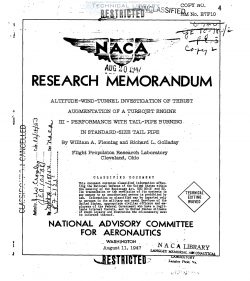naca-rm-e7f10
- Version
- 100 Downloads
- 1.65 MB File Size
- 1 File Count
- April 21, 2017 Create Date
- April 21, 2017 Last Updated
National Advisory Committee for Aeronautics, Research Memorandum - Altitude-Wind-Tunnel Investigation of Thrust Augmentation of a Turbojet Engine - III - Performance with Tail Pipe Burning in Standard Size Tail Pipe

Thrust augmentation of a turboJet engine by burning fuel in
the tail pipe has been investigated in the NACA Cleveland altitude
wind tunnel. The engine performance was determined at several
simulated flight conditions throughout a range of tail-pipe fuel
flows. A tail-pipe combustion chamber having the same external
dimensions as the standard turbojet-engine tail pipe was inves-
tigated to determine whether satisfactory operation could be
obtained at high-speed and high-altitude flight conditions.
Comparisons are made of the performance data obtained with two
different flame holders installed in this tail pipe, with a tail
pipe 54 inches in diameter, and with values calculated assuming
no preSsure loss across the tail pipe.
At a simulated altitude of 20, 000 feet and a flight Mach
number of 0.8, the net thrust of the engine was increased 76 per-
cent with the standard-size tail-pipe combustion chamber and
turning—vane flame holder. At 30,000 feet altitude and a. flight
Mach number of 0.9, the net thrust was increased 59 percent with
the standard-size tail-pipe combustion chamber and a. conical—grid
flame holder, whereas at the same simulated flight conditions the
net thrust was increased 103 percent with a 34-inch diameter
tail-pipe combustionchamber. A portion of these increases in
thrust were due to the fact that the turbine-outlet tanperature
at rated engine speed with the standard tail pipe and. tail-pipe
nozzle was below the limiting value whereas with tail-pipe burning
the turbine-outlet tanperature was at the limiting value.
The pressure loss across the standard—size tail-pipe com-
bustion chamber was greater than across the large one. The
combustion efficiency was lower with the standard-size tail-pipe
combustion chamber than with the large one. Excessively high tail-
pipe shell temperatures were observed with each of the flame holders
installed in the standard—size'tail pipe during Operation at a tail-
pipe fuel- air ratio. sufficiently high to give limiting turbine-
outlet temperature at maximum engine speed.
| File | Action |
|---|---|
| naca-rm-e7f10 Altitude-Wind-Tunnel Investigation of Thrust Augmentation of a Turbojet Engine - III - Performance with Tail Pipe Burning in Standard Size Tail Pipe.pdf | Download |

Comment On This Post